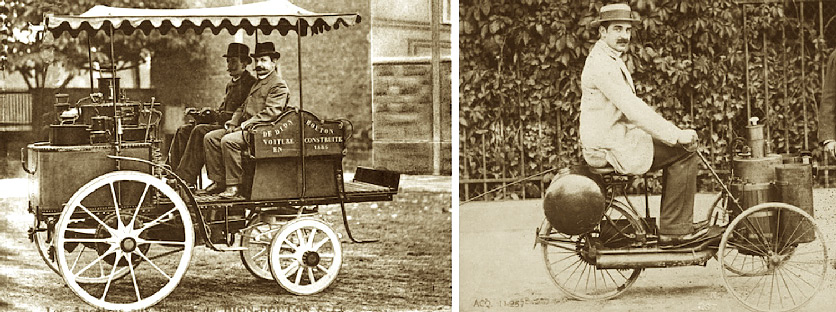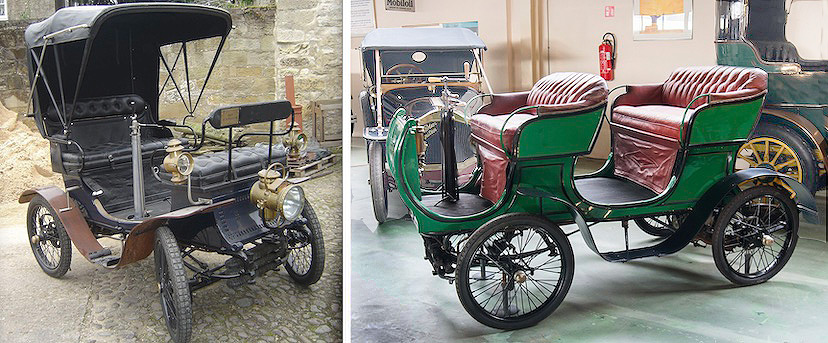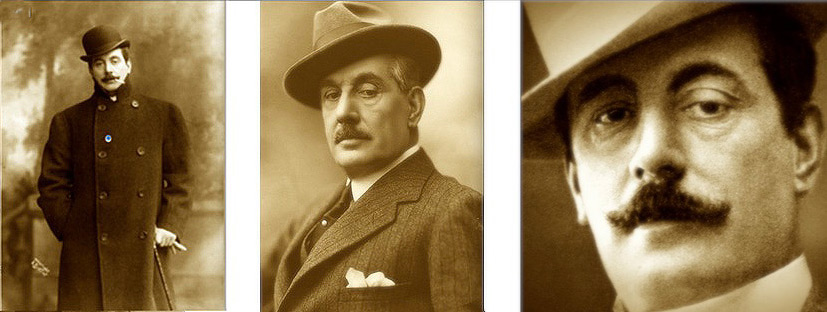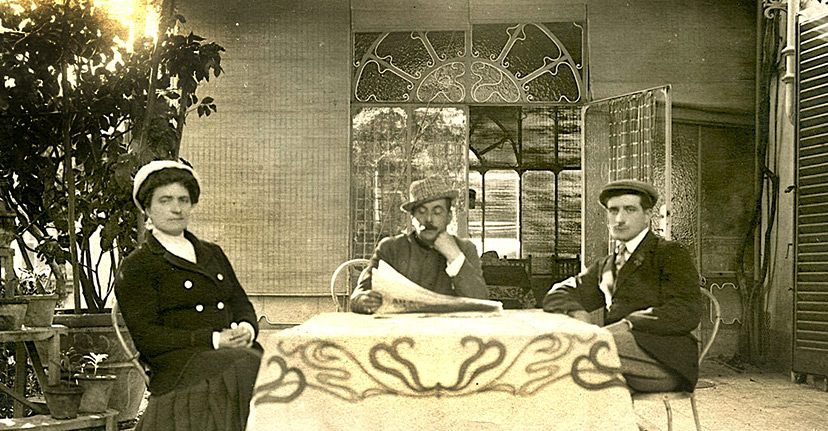Another interesting photo received from our
Forums Sleuth, Mark Dawber (New Zealand), from a forum of old photos
asking for information on the make of vehicle? Mention as a possible De
Dion Bouton but Mark has doubts it is. == Initial research advises that chap in
car is the great Italian Opera Composer Giacomo Puccini, and further
research from a number of sources agrees that this is his first car,
advised as a 1901 De Dion Bouton 5CV Tonneau. And this is only a start in
the confusion and errors about his cars.
While this is indeed basically a De Dion Bouton car, the rest of it is a conundrum. The
vehicle has central column controls, handle steering with no steering
wheel, the petrol engine crankcase can be seen rear mounted under the back
seat, yet it also has front dashboard and dummy bonnet. And on top of it
all, De Dion Bouton did not make a 5HP in 1901.
De Dion Bouton & Trepardoux company only made steam cars. Company started as
result of a visit in 1880 by Count De Dion to Paris toy-makers, brothers
in law Bouton & Trepardoux, who were eking out a living in a small
shop making toy steam engines for children. Fascinated by the principle of
steam propulsion of railway engines, and by the enthusiasm of Trepardoux
for wanting to build a full-size steam car, which they could not afford to
do, Count de Dion decided to have a punt and asked them to make a vehicle
which he would finance. The first steam car was a quadricycle which had
the boiler and engine mounted at the front, driving the front wheels by
belts, and steering was with the rear wheels. It is recorded as having
burned down to the ground on trials. By 1887 they had got the hang of it
enough for De Dion to enter one of their early cars in the first European
Motoring Competition. The car completed the course, with de Dion at the
tiller, at 60 km/h (37 mph). Further vehicles followed including single
and two cylinder Tricars with pneumatic tyres, as well as innovative steam
powered tricycles much favoured by the local dandies. At the other end of
the vehicle scale, they started to build steam powered tractor units
designed to pull normal horse drawn carriages and to build commercial
steam tractors, steam busses and trucks.

In 1889 Count De Dion decided that the future was in internal combustion
engines rather than in steam, and instructed that they should start
developing their own engines. This upset Trepardoux enough to leave the
company in 1894, at which time they changed the company name to became
simply De Dion-Bouton. By 1900, De Dion-Bouton was the largest automobile
manufacturer in the world, producing 400 cars and 3,200 engines. Embracing
the financial advantages of working with their competition, the company
started making engines for, and selling licenses to, other automobile and
motorcycle companies, with some 150 Companies using them worldwide. They
even had their own facilities in New York, USA.
So, by 1899 they had achieved a considerable experience in vehicle
manufacture, with only minor changes being needed to change from using
stream engines to petrol engines. By the turn of the century they had
2.75hp and 3.5hp engines available. The initial production of four wheeled
voiturettes started with a 3.5hp rear-engined model known as the Type 'D'.
This was was replaced in 1900 by an upgraded Type 'E' version but with the
same engine. In November 1900, the Type 'G1' appeared with a 4.5hp engine,
followed in 1901 by a variant known as the Type 'G2'. The last of rear-engined
models was the Type 'L'. The L had an identical chassis to the Type 'G'
Type but was equipped with the more powerful 6hp engine that the company
had initially installed in the first of its front-engined models from
November 1901. The voiturette provided comfort and style for two or more
passengers that a tricycle or a quadricycle could not, and it was suited
for long journeys by night or day, and simple maintenance for owner
drivers. The presence of a light, high-speed petrol engine in a relatively
lightweight body influenced many other manufacturers who adopted similar
designs for their own vehicles. By 1904, some 40,000 engines had been
supplied across Europe and the De Dion-Bouton factory at Puteaux was
employing 1,300 people and produced more than 2,000 cars.

So, what actually was the Puccini "1901 De Dion Bouton 5CV Tonneau"
car? Not a 5CV as no such engine was available at the time. So it must be
assumed he had rounded-off the 4.5CV to a 5CV, - easier to say! Rear
engine, so no later than Model L, (front engine thereafter) but cannot be a
Model L as this was 6CV; and they would surely not have rounded down by a
complete horsepower? So has to be a model G, possibly the G2 from the more
pronounced wheel-hubs. Model G was a voiturette, rear engined, of the
originally vis-à-vis configuration where the driver sat in the back seat
and passengers in the front seat facing the driver. Steering and control
lever arrangement is clearly De Dion column type, there is no steering
wheel, only a steering lever, confirming a c1900 type dating. It is fitted
with the conventional low level water cooling radiator, cooling the
cylinder barrels only. The most striking thing is that it is fitted with a
dash-board and dummy bonnet which were not fitted to De Dion cars at the
time. It is quite possible that Giacomo Puccini either asked the car to be
configured in this fashion or it was a 'show car' demonstrating advanced
features. It should be noted that the De Dion Bouton British and Colonial
Syndicate was manufacturing a rear engined tonneau with a bonnet in 1901,
and that the German licencee Cuddell, as well as De Dion themselves, were
making a forward control phaeton version of the rear engined cars.

Born in 1858 in Lucca, Giacomo Puccini was one of the greatest opera
composers in Italian history and author of masterpieces such as Madama
Butterfly. He came from a musical family which included three generations
of 'Maestro Di Cappella' of the Luca Cathedral, each writing notable music
and operas. Being only six on father's death he could not continue in his
father's job but nevertheless remained steeped in church music and
activities, composing his first Mass at 21. Orchestral pieces followed
which gained favour in Milan and which launched him on a successful and
financially profitable career of writing operas. His first opera Le Villi
came second in an opera competition but was considered so good by fellow
students and backers that free services were offered to get the opera
launched. His third work Manon Lescaut launched him as 'the most promising
composer pf his generation and 'sucessor' to Verdi'. Masterpieces such as
la Boheme, Tosca, Madama Butterfly, La Rondine and Turandot followed.
I am back on my hobby-horse subject of
copy-pasted histories without checking out the facts. Preliminary research
advises the photo is of Giacomo Puccini in his first car, a 1901 de Dion
Bouton 5CV. At that time not even the King of Italy had a car and the
total number of cars in use in Italy was only 917. Puccini did not keep
his cars long. This car was followed two years later by a Clement Bayard.
In 1905 came Sizaire Naudin, then an Ansaldo, an Isotta Faschini, then a
brace of FIATs, a La Buire, an Itala etc. His favourite make was the
Lancia of which he had a Tricapa and his final car, a 1924 Lancia Lambda,
which took him to the airport to go to Brussels for a throat operation, -
which was not successful.
His second car in most biographies is also advised as being a De Dion
Bouton 5 CV. From pictures of it, it clearly is not a De Dion Bouton. In
some biographies it is suggested that the car is Clement Bayard. From
pictures of it, it is clearly not a Bayard, the Bayard name came into use
a little later. Adolphe Clement was one of the founders of the French
motor industry and was involved in numerous motor businesses including
rights to manufacture Dunlop Tyres, Clement Gladiator Bicycles, Clement
Gladiator cars, Panhard Levassor, Clement Bayard, Clement Talbot, and many
more.

 Puccini
and his second car, 1902 Clement Tonneu, before and after the accident Puccini
and his second car, 1902 Clement Tonneu, before and after the accident
As for the Puccini car, it was a Clément. In 1902 two models were
available, a one cylinder 7hp and a two cylinder 8hp. These two models are
indistinguishable from the outside. A third smaller model was also
available with one cylinder rated at 4.5HP. In one biography it is
suggested that Puccini bought a 5HP, but it seems far more likely that
Puccini bought the bigger 8hp.
The 44-year-old Puccini was already the composer of Manon Lescaut, La
Boheme and Tosca when the accident happened, and their huge success had
brought him considerable riches. He had not been slow in spending his
money, developing a taste for dandyish clothing and penchant for acquiring
the latest cars and motor-boats to pursue his other love, of hunting and
shooting. Puccini, who was born and brought up in Lucca, always stayed
local, first buying Villa Puccini di Chiatry in nearby Torre del Lago, a
Mediterranean seaside town near the Town of Lucca, close to Pisa and
Florence. By 1900, he had acquired land and built a new villa on the lake,
now known as the "Villa Puccini", which became his permanent
residence until 1921, when pollution produced by peat works on the lake
forced him to move to Viareggio few kilometres north. Puccini loved his
cars and was fined on a number of occasions by the local magistrate for
speeding near his home.

But it was not his speeding which nearly
killed him. For normal transportation he always preferred the services of
his butler Guido Barsuglia, who knew what to do with the cars if things
went wrong. Puccini was a heavy smoker of cigars and cigarettes and was
developing a throat problem which required treatment in Lucca. On the 25th
February 1903, during a nighttime ten mile return from Lucca to his villa
with wife Elvira and son Antonio, the chauffeur misjudged in the fog a
bend at Vignola by the bridge resulting in the car coming off the road at
some 40kph down an embankment and rolling into a field. Wife and son were
thrown out, no significant injuries beyond severe shock, and the chauffeur
received a fractured broken thigh. Puccini however remained trapped under the
upturned car by his chest severely bruised and battered and was becoming
asphyxiated by petrol fumes, his right shin was also severely fractured
and bleeding.
Fortunately, a doctor was staying at a cottage nearby, and he was able to
render immediate first aid. Afterwards another doctor was sent for from
Lucca, and it was decided to make a litter and carry Puccini to Torre del
Lago by boat. Puccini's friend went with him on the boat; and, while in
great pain, the Puccini was constantly complaining that so many wild duck
flew within range, just at the time he could not shoot them. The leg did
not bheal well or quickly. It took eight
months of intensive care for him to recover fully and finish off Madame
Butterfly.

 Elvira,
Giacomo and Antonio Puccini Elvira,
Giacomo and Antonio Puccini
Puccini's love life, littered with infidelities, was as dramatic as any in
his operas. In 1884 Puccini began a relationship with a married woman
named Elvira Gemignani in Lucca while teaching her piano. Elvira's
husband, Narciso Gemignani, Puccini's school friend, was an
"unrepentant womanizer and Elvira's marriage was not happy. Elvira
became pregnant by Puccini and left Lucca when the pregnancy began to
show. Elvira, their son Antonio and Elvira's daughter by Narciso, came to
live with Puccini shortly afterwards. Narciso was subsequently killed by
the husband of another woman that Narciso had been having an affair with,
- dying one day after Puccini's car accident. Only then were Puccini and
Elvira able to marry and legitimize Antonio. Elvira was well aware of
Puccini's extramural activities, frequently with the most famous opera
singers of the day. Elvira was hot-headed, aggressive, and jealous woman
who reacted abrasively towards women. She publicly accused a Doria
Manfredi, a maid working for the Puccini family, of having an affair with
the composer. After the accusation, and local gossip, Manfredi committed
suicide. However, an autopsy determined that Manfredi had died a virgin,
refuting the allegations made against her. Elvira Puccini was prosecuted
for slander and was sentenced to more than five months in prison, although
a payment to the Manfredi family by Puccini spared Elvira from having to
serve the sentence. Much more recently it was suggested that Puccini was
actually having an affair with Doria's cousin.
Puccini continued to be a heavy smoker and his throat problems became
progressively worse. In 1924 he left Italy with Elvira and Antonio for
Belgium for treatment where the family was told that he had advanced
throat cancer. Puccini died in Brussels on 29 November 1924, aged 65 from
uncontrolled bleeding which led to a heart attack on the day after
surgery. News of his death reached Rome during a performance of La Bohème.
The opera was immediately stopped, and the orchestra played Chopin's
Funeral March for the stunned audience. Puccini's remains are housed in a
specially created chapel inside the Puccini villa at Torre del Lago. |